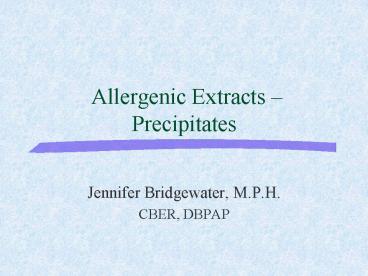Allergenic Extracts - PowerPoint PPT Presentation
1 / 17
Title:
Allergenic Extracts
Description:
Allergenic Extracts Precipitates. Jennifer Bridgewater, M.P.H.. CBER, DBPAP ... Exceptions = some cat pelt extracts, intradermal tests with 50% glycerin ... – PowerPoint PPT presentation
Number of Views:1509
Avg rating:3.0/5.0
Title: Allergenic Extracts
1
Allergenic Extracts Precipitates
- Jennifer Bridgewater, M.P.H.
- CBER, DBPAP
2
Product Line Overview
- Standardized Products (n 19)
- Short Ragweed (SRW) - glycerinated and aqueous
formulations - Cat, grasses, mites glycerinated only
- Exceptions some cat pelt extracts, intradermal
tests with lt 50 glycerin (100-1000 AU/BAU/ml) - Venoms freeze dried, HSA based diluent
- Unstandardized (n 600 - 800)
- Glycerinated and/or aqueous
3
Historical Perspective
- Precipitates recognized for many years
- Early efforts (1970s) by industry to
characterize precipitates - Physical descriptions
- Solubility properties
- Early efforts by industry to remove precipitates
- Manufacturing changes (e.g., bulk settling
steps) - Formulation changes (e.g., extraction fluids)
4
How Did Precipitate Issue Arise?
- Appearance of precipitates noted during Team
Biologics inspections of several firms
(99-present) - Areas in which precipitates were observed by
inspectors - bulk containers
- final containers
- retain samples
- customer complaint and product return files
5
Physical Characteristics of Precipitates
- Examples of terms used by industry to describe
precipitate appearance - crystalline
- flaky
- cloudy
- powdery
- tarry
- fibrous
- clumpy
6
Physical Characteristics of Precipitates
- Examples of terms used by industry to describe
precipitate appearance - color of precipitate
- ability to resuspend precipitate into solution
- amount of sediment/precipitate at bottom of vial
- percentage of extract containing precipitate
7
Current Industry Efforts to Characterize
Precipitates
- microscopic examination of precipitates
- Assess physical appearance
- Sterility testing
- Rule out microbial contamination
- IEF or SDS-PAGE examination of precipitated
extracts - In some cases profiles are similar
- In some cases bands are missing or lose definition
8
Current Industry Efforts to Characterize
Precipitates
- Potency testing of precipitated SRW extracts
- Compare potency of precipitated final container
extract to initial (release) potency value - Protein Nitrogen Units (PNU), pH, phenol testing
of precipitated extracts - Compare PNU, PH, and phenol values of
precipitated final container extract to initial
(release) value
9
Precipitate Data (Unstandardized)
Extract pH release pH retest Diff. PNU release PNU retest Percent Diff.
Penicillium 7.26 7.06 -.020 139000 136000 - 2.0
3 Weed Mix 7.08 7.65 0.57 67000 75000 12.0
Red Maple 6.8 6.5 -0.3 134000 99000 - 26.0
Scrub Oak 7.83 7.68 -0.15 53000 67000 26.0
10
Precipitate Potency Data - SRW
Lot (110 w/v) Antigen E Pre Antigen E Post Difference
A 281.7 252.2 -29.5
B 243.3 231.8 -11.5
C 317.2 204.1 -113.1
D 294.8 334.0 39.2
- Data in table taken from pooled data (2 sets of
n 19) - 5 average drop in AgE value in pooled data
difference not statistically different
11
Current Knowledge
- Aqueous extracts precipitate more than their
glycerinated counterparts - Aqueous SRW commonly precipitates
- Precipitates are a primary cause of physician
complaints (visual appearance) and product
returns to industry - Precipitates do not appear to be caused by
microbial contamination - Extraction ratio/concentration of extract and
phenol may contribute to precipitation
12
Knowledge Gaps
- Physicochemical composition of precipitates
- Long term effect on potency of the extracts
- all but one precipitated extracts are
unstandardized, therefore knowledge limited - How precipitated extracts are treated in clinical
practice - Are precipitates recognized?
- Are precipitated extracts administered as is,
decanted and administered, or returned?
13
Knowledge Gaps
- Administration of precipitated extracts
- Is there a higher risk for adverse events (AE) if
a precipitate is injected? - AE reporting for allergenic extracts (MedWatch)
is voluntary and passive - Limited number of AE reports submitted to FDA
- AE reports signal system
- Information submitted via MedWatch often
incomplete
14
Current Research Areas
- Physicochemical composition of precipitates
- Potency and stability studies of precipitated
standardized extracts (limited to aqueous SRW) - Evaluation of pH, phenol content, and PNU of
precipitated unstandardized extracts over shelf
life
15
Current Regulatory Position
- No shipment of final containers exhibiting
precipitates - Development of in-house quality control programs
(identify and describe precipitates) - Validation of any re-processing procedures
performed on precipitated extracts - Modification of labeling to address precipitates
- Submit Biological Product Deviation Reports on
precipitated lots to CBER
16
Summary
- Precipitates occur in allergenic extracts
- Aqueous extracts precipitate more than
glycerinated extracts - Almost all precipitated extracts unstandardized
- Knowledge gaps on precipitated extracts exist
- Collaborating with industry to fill knowledge
gaps - Prudent regulatory approach
17
Committee Discussion Point
- Please discuss future areas of investigation
which may provide information in ascertaining the
effect of precipitates on the administration of
allergenic extracts

